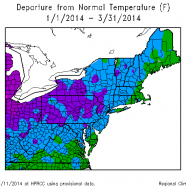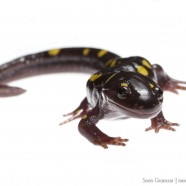April migrants at the College Lodge
This morning I visited the SUNY College Lodge, a site which you can find in our Natural History Atlas at this link. Our staff is currently conducting a year-long plant and wildlife assessment of the approximately 200-acre property owned and operated by the Faculty Student Association of SUNY Fredonia. My main target today was the beginning of the big push of migrant birds we will be enjoying throughout the region for the next month. Despite the cool weather there are still many species filtering into through the area in late April, as usual. One of the first birds I heard was the...
Read MoreThe weather of this slowww spring
Is it spring? How about now? This could turn into an, “are we there yet?!” routine rather quickly if we cannot manage to move the ridge to the East and get a consistent southerly flow soon! I think we all know it was an extremely cold winter for New England and the Mid-Atlantic but here’s more evidence if you needed to be convinced. Temperature departures of that magnitude across such large swaths of the nation are incredible. It’s notable to have a single month more than a few degrees one way or the other, forget three with huge areas 6 to 8 degrees below average and...
Read MoreSpotted Salamander (Ambystoma maculatum) by Sean Graesser
Sean called this Spotted Salamander (Ambystoma maculatum) he shot charismatic and I wholeheartedly agree! What a face.
Read MoreThrowback Thursday – Twan Leenders
Throwback Thursday! I took this photo of now RTPI President Twan Leenders while we surveyed vernal pools at Aspetuck Land Trust’s Trout Brook Valley Preserve in 2012 during the historically warm March. That memorable day we found so many critical species including some not expected until June!
Read MoreAmphibians emerging
Yesterday it was over 50 degrees and raining in Western New York and more warm and wet weather will be on the way – ideal conditions for frogs, toads and salamanders to emerge from hibernation and start migrating to a nearby wetland at night! Please slow down for salamanders and frogs when you’re driving back roads near wetlands – even when they don’t get crushed by your tires, the slipstream generated underneath a vehicle when you’re moving more than 20-25 MPH will pick these animals up from the road surface and slam them into the underside of your car…...
Read More








